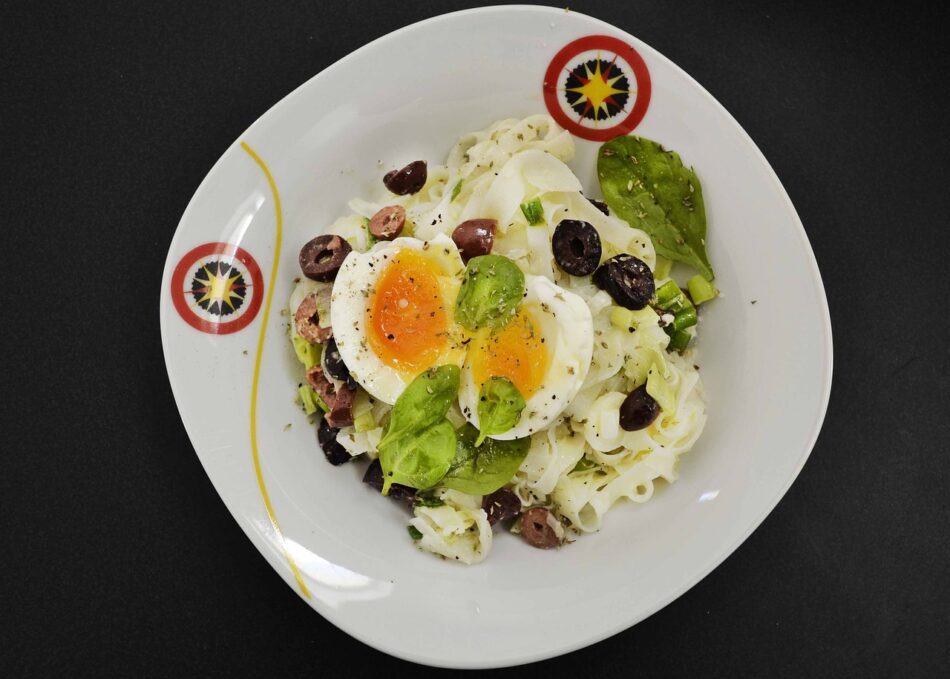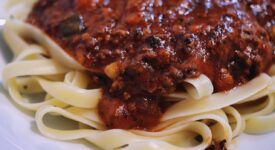Are you tired of your pasta turning out either too mushy or too hard? Boiling perfect pasta every time can seem like a daunting task, but with the right steps and tips, it can be a simple and satisfying process.
First things first, choosing the right pasta shape and size for your sauce is important for a perfectly boiled pasta. Once you have your preferred pasta, use a large pot and fill it with plenty of water. You need at least 4-6 quarts of water for 1 pound of pasta. Don’t forget to add salt to the boiling water before adding pasta – this small step enhances the flavor of the pasta. One tablespoon of salt per quart of water is a good rule of thumb.
Bring the water to a rolling boil over high heat before adding your pasta. Then, add your pasta to the pot and stir immediately to prevent it from sticking together. Cook the pasta according to the package instructions for al dente. Don’t overcook your pasta – check for doneness a few minutes before the recommended cooking time. Overcooked pasta will lose its texture and taste mushy.
Once cooked, drain the pasta quickly and efficiently. Don’t rinse it unless you’re making a cold pasta dish. Finally, toss your boiled pasta with your favorite sauce and toppings and serve hot. With these easy steps, you can wow your family and friends with perfectly boiled pasta every time!
Choose the Right Pasta
When it comes to boiling pasta, choosing the right pasta shape and size is essential for a flavorful and perfectly cooked dish. Different pasta shapes hold onto sauces in different ways, making it important to choose a shape that complements your sauce. For thicker, meat-based sauces, choose a pasta shape with ridges or nooks to hold onto the sauce. For lighter, oil-based sauces, choose a smoother pasta shape.
The size of the pasta is also important to consider. Larger shapes like rigatoni or penne will take longer to cook than smaller pasta shapes like fusilli or spaghetti. It’s important to use the recommended cook time on the pasta package as a guide, but also to taste the pasta a few minutes before the recommended cook time to ensure it is cooked al dente.
To make things easier, there are some classic pasta and sauce pairings that work well together. For example, spaghetti pairs well with marinara sauce, while fettuccine is best served with a creamy Alfredo sauce. Overall, choosing the right pasta shape and size is crucial to ensure a perfectly boiled pasta that complements your sauce and enhances the overall taste of the dish.
Fill the Pot with Enough Water
To boil perfect pasta every time, the first step is choosing the right pot and filling it with enough water. It is recommended to use a large pot and fill it with at least 4-6 quarts of water for every pound of pasta. This ensures that the pasta has enough room to move around and cook evenly.
When filling the pot with water, make sure to leave enough space for the pasta to be added later. It is important to note that pasta can expand up to twice their size when cooked, which is why a larger pot is always recommended.
Using a pot that is too small can result in the pasta being overcrowded, leading to uneven cooking and clumping of the pasta. It can also cause the water temperature to drop drastically, resulting in the pasta cooking too slowly or becoming mushy.
Once the pot is filled with enough water, it’s time to add salt. One tablespoon of salt per quart of water is a good rule of thumb. This not only flavors the pasta but also helps to prevent the pasta from sticking together.
Overall, filling the pot with enough water and adding salt are essential elements to boil perfect pasta every time. It may seem like a small detail, but it makes a huge difference in the final result.
Add Salt to the Water
When boiling pasta, adding salt to the water before adding the raw pasta is a crucial step. This not only enhances the flavor of the pasta but also helps to season the pasta from the inside out. A good rule of thumb is to use one tablespoon of salt per quart of water. It is important to add the salt to the boiling water and not before, as the latter can cause uneven distribution of the salt. The salted water should be at a rolling boil before adding the pasta.
It is also important to note that adding oil to the water is unnecessary and can actually prevent the pasta from absorbing the sauce properly. So, the next time you boil pasta, don’t forget to add salt to the boiling water for a more flavorful and well-seasoned finished dish.
One tablespoon of salt per quart of water is a good rule of thumb.
When boiling pasta, it is important to add salt to the water before adding the pasta. The general rule of thumb is to add one tablespoon of salt per quart of water. This may seem like a lot of salt, but remember that most of the salt gets drained off with the water. Adding salt to the water enhances the flavor of the pasta and makes it taste better.
Once you have added salt to the water, bring it to a rolling boil over high heat before adding your pasta. It is important to use a large pot and fill it with plenty of water. You need at least 4-6 quarts of water for 1 pound of pasta. Adding enough water helps to prevent the pasta from sticking together and ensures that it cooks evenly. Remember to stir the pasta immediately after adding it to the boiling water to prevent it from sticking together.
Add Pasta to the Boiling Water
When adding your pasta to the boiling water, make sure to stir it immediately to prevent it from sticking together. This also ensures that the pasta cooks evenly. Use a pasta spoon or tongs to gently stir the pasta for a few seconds after adding it to the pot.
Make sure to also avoid overfilling the pot with pasta. It’s important to have enough water for the pasta to move around freely and cook properly. If the pot is too crowded, the pasta may stick together and not cook evenly.
Additionally, it’s important to pay attention to the cooking time recommended on the pasta package. Different pasta shapes and sizes may require different cooking times, so make sure to check the instructions. Overcooking the pasta can result in a mushy texture and an unpleasant taste.
Overall, adding pasta to boiling water may seem like a simple task, but it’s crucial for achieving perfectly cooked pasta. By following these tips and techniques, you can create a delicious pasta dish every time.
Cook the Pasta
To cook the perfect pasta, you need to follow the instructions on the package for al dente. Al dente pasta is cooked but still firm to the bite. This means it is not mushy or overcooked. To achieve this, cook the pasta for the recommended time on the package, and then taste it a few minutes before the end of the cooking time to ensure it is not overcooked.
When cooking the pasta, make sure to use enough water. You need at least 4-6 quarts of water for every pound of pasta. This allows the pasta to cook evenly and prevents it from sticking together. Once the water comes to a rolling boil, add the pasta and stir immediately to prevent sticking.
While the pasta is cooking, it’s important to stay nearby and keep an eye on it. Stir it occasionally to make sure it cooks evenly and doesn’t clump together. Once the pasta is done, drain it quickly and efficiently, without rinsing it unless you’re making a cold pasta dish.
With these simple steps, you can cook perfect al dente pasta every time. Just follow the package instructions, use plenty of water, keep an eye on the pasta as it cooks, and drain it quickly once it’s done.
Don’t Overcook
When cooking pasta, it’s important to not overcook it. Overcooked pasta will lose its texture and taste mushy, which can ruin the dish. To ensure that your pasta turns out perfectly, you should check it for doneness a few minutes before the recommended cooking time. Keep in mind that the time on the package is just a guideline, and the actual cooking time may vary depending on the type and shape of pasta you’re cooking.
To check if the pasta is done, simply taste a piece. It should be cooked through but still slightly firm (al dente). If it’s too hard or crunchy, continue cooking for another minute or two. If it’s too soft, you’ve overcooked it and it’s time to drain the pasta.
Remember, the pasta will continue to cook for a few minutes after you drain it, so it’s better to slightly undercook it rather than overcook it. Once drained, the pasta is ready to be tossed with your favorite sauce and served hot.
Drain the Pasta
Once the pasta has reached the perfect al dente texture, it’s time to drain it. You’ll want to do this quickly and efficiently to prevent the pasta from becoming mushy.
Start by using a colander to strain the pasta, and be sure to shake off any excess water. If you’re making a hot pasta dish, avoid rinsing the pasta under cold water. This can remove the starches that help the sauce adhere to the pasta, resulting in a less flavorful dish.
However, if you’re making a cold pasta dish like a pasta salad, rinsing the pasta under cold water can help stop the cooking process and prevent the noodles from sticking together.
Once you’ve drained your pasta, it’s time to add your desired sauce and toppings. Toss everything together and serve hot for a delicious and satisfying meal.
Finish with Sauce
After draining the pasta, it’s time to add your desired sauce. Use a large, wide pan to mix the pasta and sauce together to ensure that all the pasta gets coated evenly. If you’re making a cream-based sauce, you may need to add a little bit of pasta water to the saucepan to help it emulsify and thicken up. Add any additional toppings, such as grated cheese or fresh herbs, to complete the dish. Give it a quick toss and serve immediately. Hot pasta dishes should be served hot, while cold pasta dishes can be chilled in the refrigerator before serving. Enjoy your perfectly boiled pasta!








